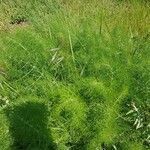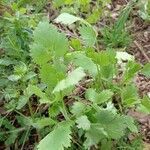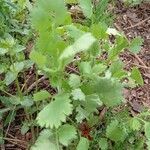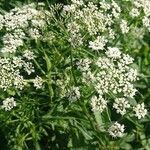Annual. Stems erect, terete, grooved, pubescent. Petioles of the lower leaves 4-10 cm, upper ones gradually shorter, uppermost leaves sessile, all with membranously margined sheaths, lower lamina cordate, crenate to serrate, subsequent ones successively incised, ternate and nearly pinnate, leaflets dentate to incised. Umbels terminal to the stems and its branches; peduncles 2½-7 cm; rays 8-14, 4-25 mm; pedicels 7-13, 1-5 mm; involucres 0-2, 3-4 mm, narrow; involucels 0-2, 1 mm, subulate. Petals nearly 1 mm, obcordate with inflexed tips. Mericarps to 5 by 2 mm, ellipsoid, short-hairy by antrorse hairs.
A herb which re-grows from seed each year. It grows 50-60 cm high. It spreads 40-50 cm wide. The leaves near the ground are simple, broad and oval. The leaves on the stems are finely cut into 3 leaflets. These are feathery looking leaves. The leaves are mid green and have teeth around the edge. The flowers form flat white heads. These are on wispy, fine stems. The seed are about 3 mm long. They are oval and curved. They are pale brown.
P. major (L.) Hudson, with hollow stem and prominently ribbed, pentagonal mericarps, and P. anisum L., with puberulent frs, are merely casual or waifs with us.




